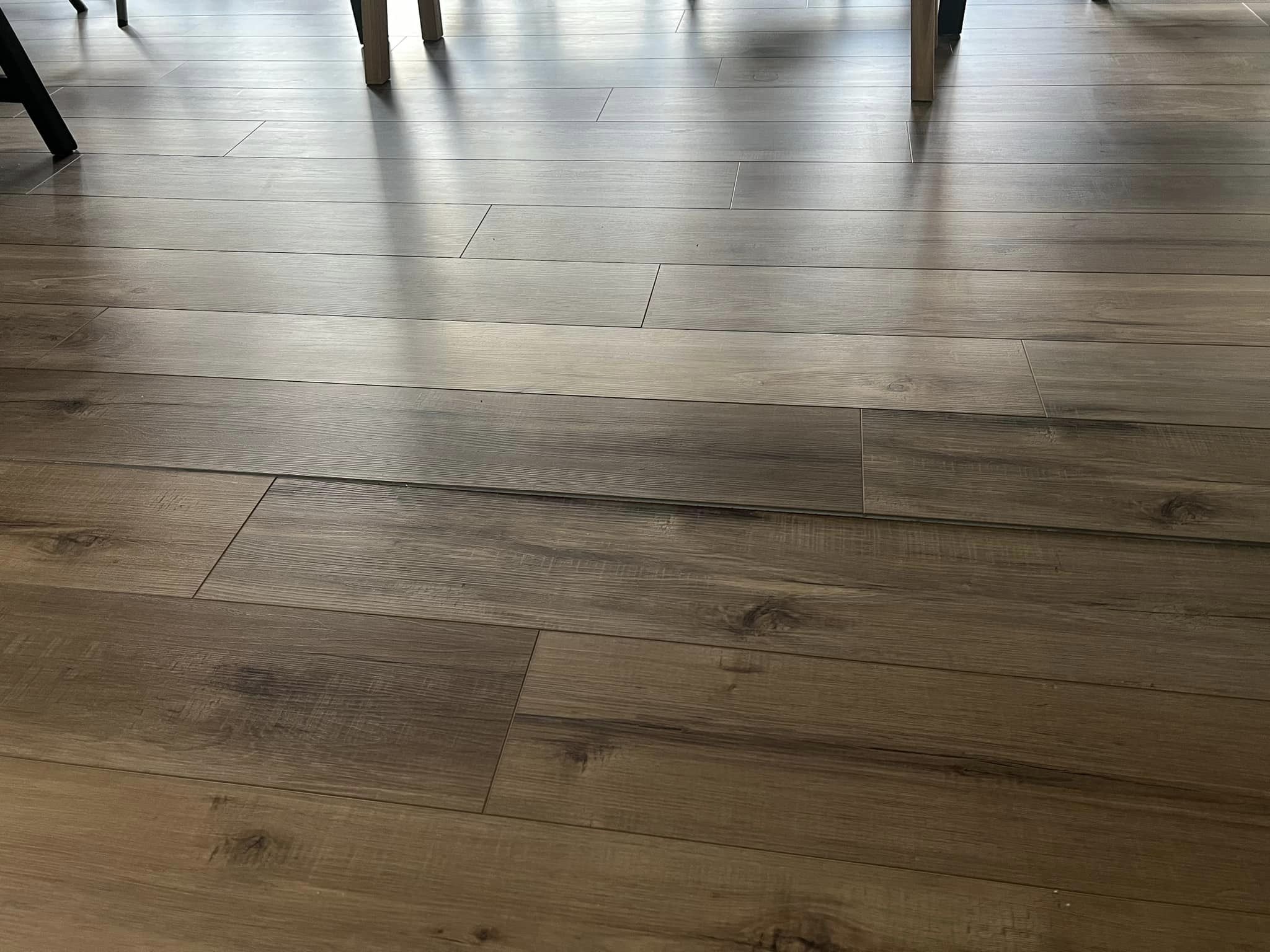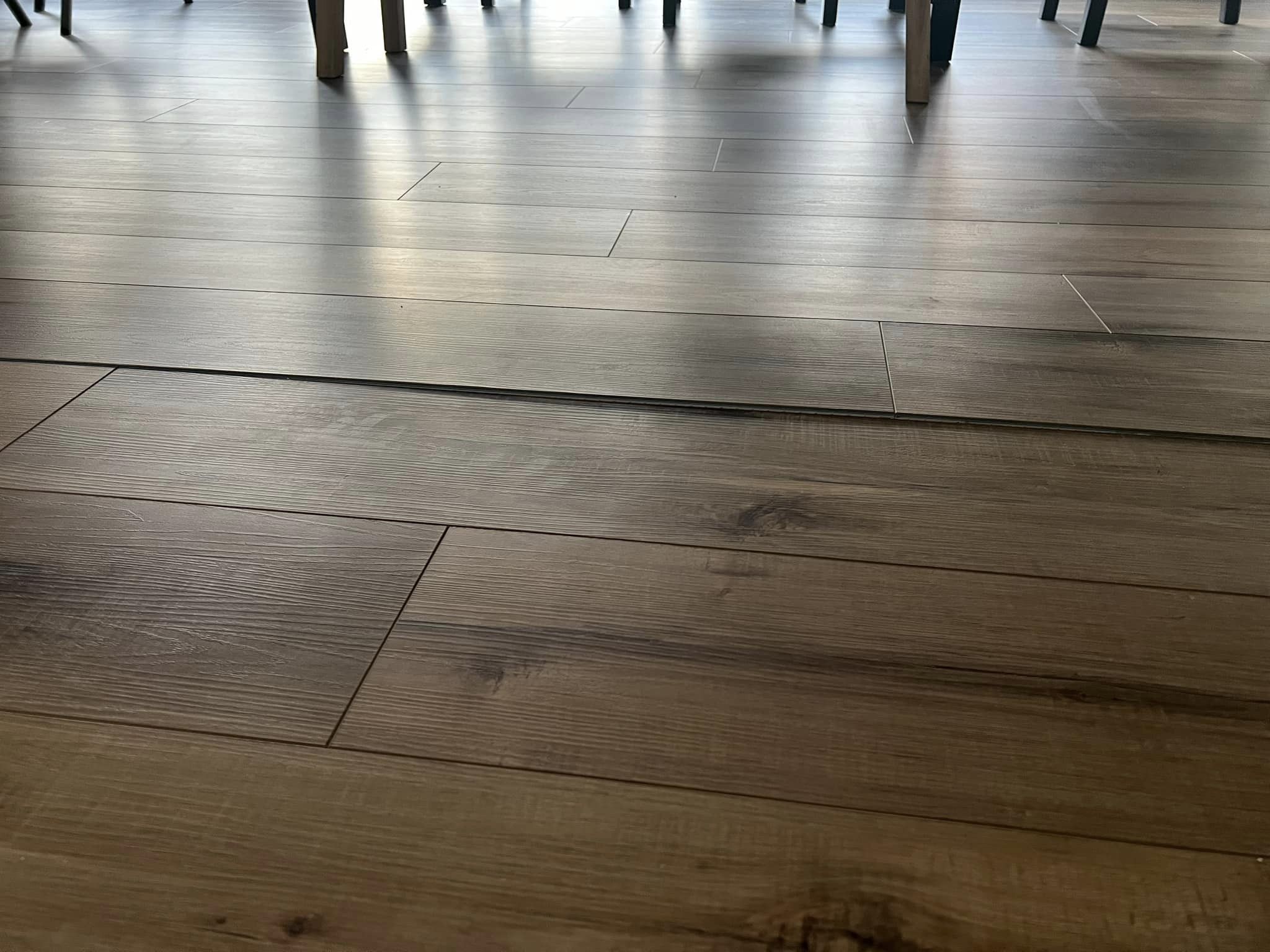How can I fix a bump in my LVP flooring that was not originally intended to be installed over cement?
11 months ago
Last Updated: July 26, 2024
Hey there! So I recently had LVP flooring installed over cement, which wasn’t part of the original plan. The person doing the installation convinced me to remove the carpet and go with this flooring instead. Now there’s a weird bump on the lower half of it. The installer mentioned putting something underneath to lay the panels, but it didn’t turn out well. Any suggestions on how to fix this issue?


I really hope the solution turns out to be easy. Is the bump in the flooring itself or on the concrete below?
You might want to consider lifting the flooring up to that spot and applying a layer of thin set to even out the surface in that specific area before reinstalling. I suggest asking the installer to handle this task, as ensuring these issues are addressed should have been part of their initial responsibilities. If I were in your position, I would thoroughly inspect the entire floor that was installed to check for any similar issues.
Gave a spot-on response
I’m in total agreement, .
Grind it until it’s smooth
‘t do that!
Come on, Mr. Einstein. You gotta either grind or plane that area down, or level up the rest of the floor… Have you checked the price of self leveler lately? Haha
I’m just a construction worker. What do I know, right? Haha
Might believe you’re talking about smoothing out the lvp.
Haha yes I jumped to conclusions. He might have even been the original ‘Builder’ responsible for that mess 🙂 It’s fine to grind the Substrate!
What kind of silly person would believe that I was suggesting grinding 1/8 inch planking with a 16th of finish on top????? Haha
Sounds like you might be the one who created this mess. Shame on you. You probably even marked up the floor with your spurs.
Exactly… I’m actually from Philly, you dummy… haha
You’re starting to sound like you should maybe just hush up…. haha
The floor looks great, but unfortunately fixing a small area means removing everything around it.
Go ahead and use the hammer/mallet to really give it a good hit!
One option is to remove the damaged area and replace it. Search for tutorials on how to replace a section in the middle. Whenever possible, use the original tongue and groove pieces and only glue together the parts that can’t connect to the slab.
It might be a good idea to contact the contractor and ask him to rectify the situation. If he refuses, consider taking legal action.
It seems like the flooring was mistakenly put in the wrong direction. I believe if it had been installed differently, this issue could have been avoided. Additionally, the flooring may be too close to the walls.
I have a feeling he forgot to use an underlayment or self-leveling concrete to ensure the floor was perfectly level. We installed bamboo floors that ended up buckling because the workers didn’t include the underlayment.
Contact the contractor for assistance
Lift and level the floor
I’m so sorry to hear about the problem you’re facing, . Unfortunately, I can’t offer much help. However, could you possibly share the brand and color of your lovely LVP?
I got the POMPANO PINE flooring from floor and decor.
That’s unfortunate. It doesn’t seem like it’s due to an uneven floor. I’m curious if the locking mechanism was affected during the installation process.
Thank you everyone for sharing your input and thoughts.
I had a similar experience; the contractor returned four months later and replaced the entire floor at their own expense
Can a grinder be rented?
You know , you don’t really need a grinder.
Not interested?
We recently installed LVP on our basement cement floor and noticed it’s uneven. Looks like the pieces weren’t properly locked together. I think we’ll need the installer to come back and fix it.
Hey there! It seems like you’re dealing with a bit of a flooring challenge. When installing LVP (Luxury Vinyl Plank) on concrete, it’s really important to ensure the surface is smooth and level. Any bumps or uneven areas can lead to the issues you’re experiencing.
Here’s a practical way to address the situation:
1. **Identify the Problem**: Figure out how extensive the issue is. Is it isolated to one plank or affecting a larger area?
2. **Remove the Affected Planks**: Gently take out the planks surrounding the problematic spot. Handle them carefully to prevent any damage.
3. **Inspect and Prep the Subfloor**: Examine the concrete underneath. Is there a specific reason for the bump? It could be a raised area in the concrete or debris trapped below.
4. **Level the Area**: If there’s a raised spot, you might need to grind it down. For minor unevenness, a self-leveling compound could be the solution. Ensure the concrete is clean and dry before proceeding.
5. **Reinstall the Planks**: Once the subfloor is prepped and level, you can put the LVP back in place. If the original planks are beyond repair, consider using new ones.
6. **Inspect the Entire Floor**: After addressing the problem area, check the entire floor for any other potential issues.
Remember, patience and thoroughness are important. If you’re unsure about handling this yourself, consulting another flooring professional could be beneficial.
I hope these steps help you restore your floor to its former glory!
Robert
Wesley Moore
The key is in the subfloor… rip it up and ensure a smooth transition.
What color is it? It’s really lovely!
Check out the POMPANO PINE at floor and decor, recommended by .
Appreciate the shoutout, !
Make sure the subfloor for that material is very flat.
Give the guy a call and ask him to come back and make it right.
Who is this guy you’re referring to? Is he a friend or just another handyman working for cash? If he’s a professional, he should be held accountable for the work done and you should reach out to have it corrected. If he was a discounted handyman, you may need to remove a lot of the floor to address the issue. Remember, ‘failure is the best teacher’ in situations like this. Best of luck.
I had a mix of carpet and tile… the concrete floor absorbed it unevenly, so we applied leveler over the uneven spots before gluing down the tiles.